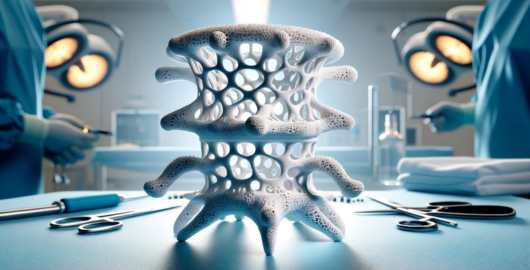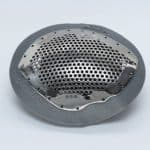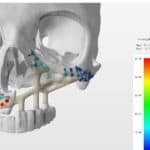
Alyssa Huffman is the inventor, founder, and CEO of Allumin8. A company dedicated to bringing research-backed innovation to 3D printed orthopedic and spine hardware in an effort to increase implant survivorship and reduce the likelihood of catastrophic revisions. Allumin8’s implants (including the A8 Integr8 Porous Pedicle Screw System – not cleared for sale in the US) are designed to match the trabecular pattern of bone with the intent to study a variety of biologic therapeutics delivered through or drawn into the hardware. No change in surgical technique. No change in care. No change in pricing. Simply providing options that never before existed in hardware for the betterment of the patient. Licensing opportunities are available by contacting alyssa@allumin8.com. Alyssa will join us in San Francisco for our 3D Technologies, AI, for Orthopedics event soon.
When was the first encounter you had with 3D printing? What was that experience like? What were you thinking at that moment?
Alyssa: I was reading an article on LinkedIn about how additive manufacturing could revolutionize many industries (including orthopedics and spine). I never wanted to fall behind, so I started researching additive manufacturing and connecting with great minds in the arena, such as Matthew Shomper. It was quickly apparent that 3D printing was the future and could produce products that were only a twinkle in someone’s eyes just decades prior.
What inspired you to start your journey?
Alyssa: 3D Printing was the only manufacturing option that would facilitate the details of the designs. While working since 2007 as a distributor and rep for some of the largest companies in total joints, trauma, extremities, spine, sports medicine, and biologics, my Uncle, Richard Whittington, at 63 years old, had a failed lumbar fusion. His screws backed out, and his rods broke. Coincidentally, my twenty-one-year-old cousin, who was living with incomplete quadriplegia, experienced the same result. My uncle would eventually have six failed spine surgeries.
If someone is 45 and in good health, things are pretty straightforward. But if you have a diabetic patient—like my uncle—then the risk of a poor outcome, infection, or immune system issues skyrocket.
I simply grew tired of watching failures occur while seeing their effects on the patient and their loved ones. The industry needed a new perspective on design, which would more closely reflect research, build on what is available to surgeons within the hospitals, and incorporate gold standard practices and emerging advanced manufacturing technologies.
In 2009, I began sketching out some design concepts for reducing screw pull-out and rod breakage.
After running across a paper published in Biomaterials & Tissue Biomechanics, written by Professor Amir A. Zadpoor, Ph.D., comparing the architecture of bone in the vertebrae to other areas in the body, I decided to concentrate not only on hardware stabilization in bone but also using the hardware to deliver much-needed therapies to patients.
Vertebral bone is much more porous…the lattice structure is thinner and more rounded. This helps explain why bone in the spine needs more assistance concerning the demands of hardware.
Who inspired you the most along this journey in 3D printing?
Alyssa: At the persistent urging of my mentor, the late Dr Luke Vaughan, former Orthopedic Oncology Director at the Scripps Institute, I kept working on my personal project – reducing pedicle screw failure. At that time, I didn’t have a lot of support and honestly didn’t believe a woman without a research or surgical background in the Midwest could go up against the likes of Titans in the field. So, my dedication waxed and waned.
This was until a few catastrophic events in a short period led me to realize that if I wasn’t willing to bet on myself, why should anyone else? Therefore, I invested in an EMBA at Washington University – St Louis and was met with the unyielding support of Professor Ron King. I’ll never forget Dr King asking me if I’d be interested in pitching my company to his core group supporting the entrepreneurial journey. It was this group that gave me the confidence to keep pursuing what came to be ALLUMIN8 and the A8 Porous Pedicle Screw System.
Spine, Orthopedic, and 3D Printing Guru Randy Theken was another supporter early on in the journey. He connected me with people in the industry who could help guide the trip without overcharging the company.
Last but not least, my father is a retired orthopedic flight surgeon in the Air Force. Like him, I enjoy research, thinking limitlessly, and focusing.

What motivates you the most for your work?
Alyssa: The year 2018 took a turn for the worse. My marriage was unraveling, and I had a young son whom I needed to support. Around the same time, I jumped into a taxi cab and, on the way to her destination, was slammed by a drunk driver speeding along at 77 mph. I endured several injuries, most seriously a traumatic brain injury and fractures at the rib/spine junction. That started the journey of needing multiple surgeries, trigeminal neuralgia, and lawsuits. I told my employer I required sick leave for emergency brain surgery and was laid off after being a top performer. Then there was the PTSD.
I was at a crossroads in life.
Giving up wasn’t an option. Working for a large company wasn’t an option anymore. I was tired of being disposable after delivering great successes for companies.
If I wasn’t willing to bet on myself, why should anyone else?
I wanted to teach my son he could thrive through life’s failures by growing mentally, physically, and spiritually. So, the first thing I did was invest in myself to bring my pet pedicle screw project to fruition by getting an MBA at Washington University – St Louis. I had always believed these designs could really help patients, surgeons, and hospitals alike. Now, I had to prove it.
What is/are the biggest obstacle(s) in your line of work? If you have conquered them, what were your solutions?
Alyssa: Additive manufacturing is relatively new in orthopedics and spine. It took years to find our CTO, Matthew Shomper. He was the first engineer with enough design experience to translate my ideas into something that could pass 5 million cycles and meet ASTM standards.
Also, despite women founders historically having significantly better returns, sourcing capital has been challenging. “Women are massively under-represented among both venture-backed entrepreneurs and VC investors, with companies founded solely by women receiving less than 3% of all venture capital investments and women accounting for less than 15% of check-writers.”¹
What do you think is (are) the biggest challenge(s) in 3D Printing/bio-printing? What do you think the potential solution(s) is (are)?
Alyssa: Technology is advancing so quickly, it is easy for a company to acquire the best machines. However, if they don’t understand the art of design and where the failures lie in manufacturing a lot of resources will be wasted and failures will inevitably occur. AI can teach knowledge, but only failures leading to successes create wisdom.
One solution would be to offer high school students an opportunity to be certified in additive manufacturing to start the journey early. I’m a big advocate of high schools offering certifications for labor-oriented professions that students can fall back on should their college experience not go as planned.
If a higher being granted you three wishes, what would they be?
Alyssa:
1. The hardware we are bringing to market will significantly reduce revision rates globally for patients and give them, their families, and their Surgeons a better quality of life.
2. We forever change the way orthopedic and spine implants are designed to incorporate therapeutics.
3. People worldwide would think without limitations (including the limitations our Parents and cultures taught us to believe). Living life with curiosity and wonderment is a gift we can give to ourselves.
What advice would you give to a smart, driven college student in the “real world”? What bad advice have you heard that they should ignore?
Alyssa:
- Find your mentors.
- Never stop being curious.
- Connect with the leaders and learn from the best.
- Never be afraid to fail, but be calculated and fail fast.
- Define who you want to be, write down what prevents you from getting there, and write down how you are aligned.
- Make a plan.
- Think and act limitlessly.
- Invest in yourself.
- Family and God/Higher Power come first. They’re the only ones to pick you back up when failure occurs.
I was once criticized by a manager who stated I needed to stop reading research because my job was to sell. He said it made it look like I was trying to be the smartest person in the room. It’s easy to say I overlooked it, but comments like that creep into the psyche.
Just because I wasn’t a researcher didn’t mean I couldn’t read data from all over the world and correlate the emerging trends.
I’ve seen it all. From shady business partners to unethical management and poor business practices. There are no shortcuts to quality and integrity.
What’s your favorite book you read this year and why? Alternatively, what’s your favorite book of all times you read and why?
Alyssa: I read “The Four Agreements” by Don Miguel Ruiz almost every year. It changed my entire perspective on how to live life.
Agreement 1: Be impeccable with your word.
Agreement 2: Don’t take anything personally.
Agreement 3: Don’t make assumptions.
Agreement 4: Do your best.
Newly adopted Agreement 5: Be skeptical, but learn to listen.
References:
- “For Female Founders, Fundraising Only from Female Vcs Comes at a Cost.” Harvard Business Review, 1 Feb. 2023, hbr.org/2023/02/for-female-founders-only-fundraising-from-female-vcs-comes-at-a-cost.
Related Articles:
Interview with Craig Rosenblum: 3D Printing Post Processing
Interview with Kerim Genc: The Power of Artificial Intelligence and 3D Printing
Artificial Intelligence and 3D Printing (Expert Corner)
Artificial Intelligence in Healthcare 3D Printing (On Demand, 2021)




 Feb 03, 2024
Feb 03, 2024 






Comments